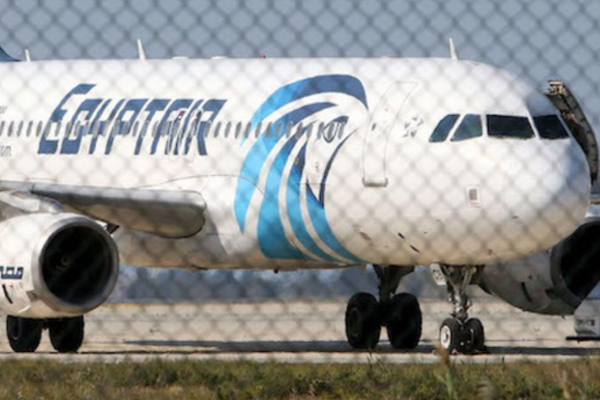
EgyptAir plane hijacker surrenders
ATHENS, March 29, 2016
An EgyptAir plane flying from Alexandria to Cairo was hijacked and forced to land in Cyprus on Tuesday but the passengers and crew were freed unharmed and the hijacker, whose motives remained a mystery, was arrested after giving himself up.
Eighty-one people, including 21 foreigners and 15 crew, had been onboard the Airbus 320 flight when it took off, Egypt's Civil Aviation Ministry said in a statement.
Conflicting theories emerged about the hijacker's motives, with Cypriot officials saying early on the incident did not appear related to terrorism but the Cypriot state broadcaster saying he had demanded the release of women prisoners in Egypt.
After the aircraft landed at Larnaca airport, negotiations began and everyone onboard was freed except three passengers and four crew, Egypt's Civil Aviation Minister Sherif Fethy said.
Soon after his comments, Cypriot television footage showed several people leaving the plane via the stairs and another man climbing out of the cockpit window and running off.
The hijacker then surrendered to authorities.
"Its over," the Cypriot foreign ministry said in a tweet.
Speaking to reporters after the crisis ended, Egyptian Prime Minister Sherif Ismail said the hijacker was an Egyptian national but that his motives remained unclear.
"At some moments he asked to meet with a representative of the European Union and at other points he asked to go to another airport but there was nothing specific," he said, adding that the man would now be questioned to ascertain his motives.
Cypriot foreign ministry official Alexandros Zenon told reporters during the crisis that the hijacker apppeared to be "unstable".
Egypt's Civil Aviation Ministry said the plane's pilot, Omar al-Gammal, had informed authorities that he was threatened by a passenger who claimed to be wearing a suicide explosives belt and forced him to divert the plane to Larnaca.
Photographs shown on Egyptian state television showed a middle-aged man on a plane wearing glasses and displaying a white belt with bulging pockets and protruding wires.
Fethy, the Egyptian minister, said authorities suspected the suicide belt was not genuine but treated the incident as serious to ensure the safety of all those on board.
"Our passengers are all well and the crew is all well... We cannot say this was a terrorist act... he was not a professional," Fethy told reporters after the incident.
In the midst of the crisis, witnesses said the hijacker had thrown a letter on the apron in Larnaca, written in Arabic, asking that it be delivered to his ex-wife, who is Cypriot.
But the Cyprus Broadcasting Corporation (CyBC) said the hijacker had asked for the release of women prisoners in Egypt, suggesting a political motive.
EgyptAir also delayed a New York-bound flight from Cairo onto which some passengers of the hijacked plane had been due to connect. Fethy said it was delayed partly due to a technical issue but partly as a precaution.
The plane remained on the tarmac at Larnaca throughout the morning while Cypriot security forces took up positions around the scene.
EGYPT'S IMAGE
While the reasons for the hijacking were not entirely clear, the incident will deal another blow to Egypt's tourism industry and hurt efforts to revive an economy hammered by political unrest following the 2011 uprising.
The sector, a main source of hard currency for the import-dependent county, was already reeling from the crash of a Russian passenger plane in the Sinai in late October.
President Abdel Fattah al-Sisi has said the Russian plane was brought down by a terrorist attack. Islamic State has said it planted a bomb on board, killing all 224 people on board.
The incident has raised renewed questions over airport security in Egypt, though it was not clear whether the hijacker was even armed. Ismail said stringent measures were in place.
There was also some confusion over the identity of the hijacker. Egypt's official state news agency Mena initially named him as Egyptian national Ibrahim Samaha but later said the hijacker was called Seif Eldin Mustafa.
The Cypriot Foreign Affairs Ministry also identified the hijacker as Mustafa.
Passengers on the plane included eight Americans, four Britons, four Dutch, two Belgians, an Italian, a Syrian and French national, the Civil Aviation Ministry.
Cyprus has seen little militant activity for decades, despite its proximity to the Middle East.
A botched attempt by Egyptian commandos to storm a hijacked airliner at Larnaca airport led to the disruption of diplomatic relations between Cyprus and Egypt in 1978.
In 1988, a Kuwaiti airliner which had been hijacked from Bangkok to Kuwait in a 16-day siege had a stopover in Larnaca, where two hostages were killed.
Egypt said it would send a plane to Cyprus to pick up stranded passengers, some of whom had been traveling to Cairo for connecting flights abroad. - Reuters








